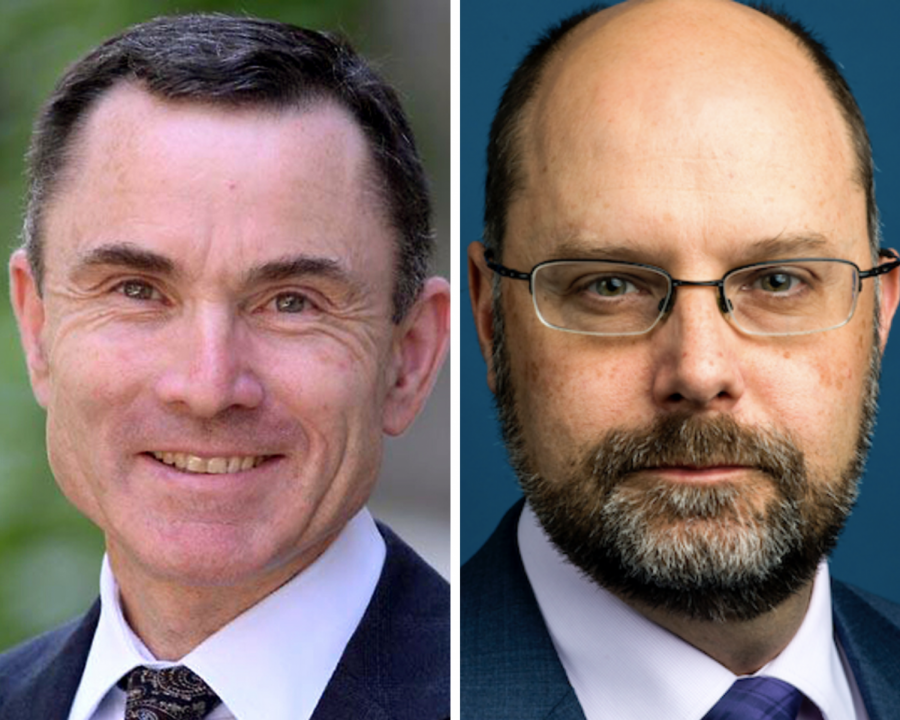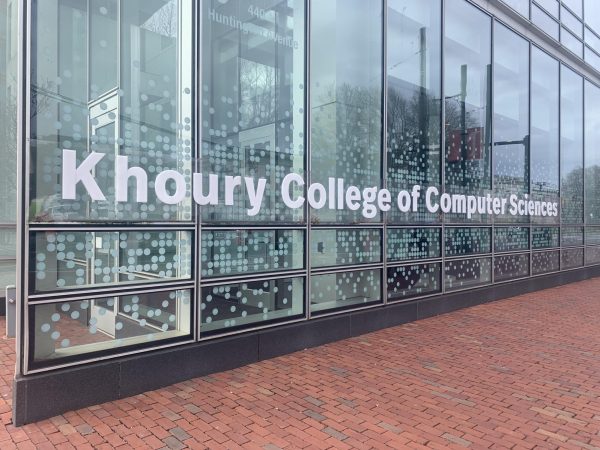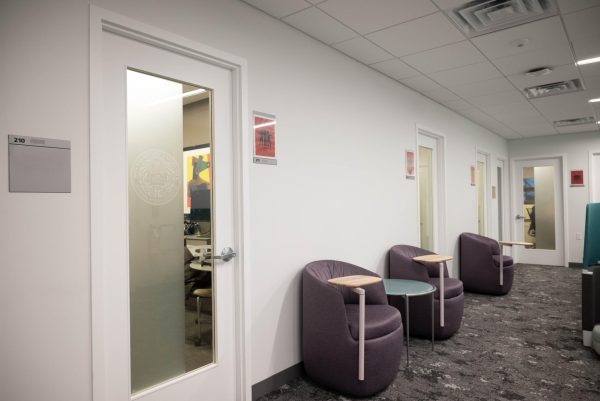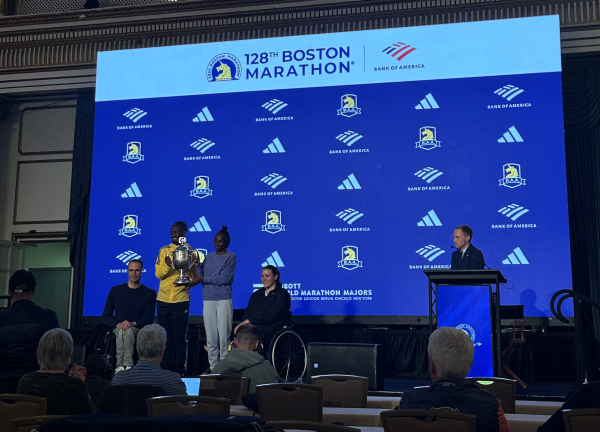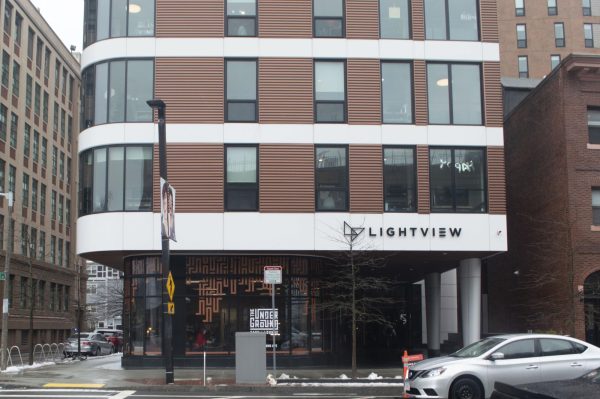Q&A: Provost Madigan and Chancellor Henderson discuss reopening
Photos courtesy News@Northeastern
David Madigan (left) and Ken Henderson (right).
June 16, 2020
Provost and Senior Vice President for Academic Affairs David Madigan and Chancellor and Senior Vice President for Learning Ken Henderson discussed reopening and the fall semester in a video call with The News on Tuesday.
Madigan and Henderson addressed major issues, including: accommodation of professors’ individual risk factors, some student housing in local hotels and the university’s acquisition of more than 1 million masks. The two administrators said they are currently confident in the N.U.in program running overseas, but if students cannot remain abroad, Northeastern will be able to host them in Boston. Clubs on the Boston campus may be able to hold socially-distant meetings on campus, and financial aid will not be affected if students defer this semester. Other topics of importance are discussed throughout the interview.
The following transcript has been edited for length and clarity.
The Huntington News: With NUflex, we understand students will be able to choose between in-person and online instruction. Will professors have that same option?
David Madigan: We hope that many faculty and many students will choose to come to campus, subject to limitations of wearing masks and all the rest of it. With faculty, certainly if a faculty member has risk factors like being elderly or having diabetes, then they probably shouldn’t come to campus, and we will accommodate that for sure. There will be other situations where there will be extenuating circumstances like childcare difficulties, an elderly person at home, high anxiety. We will be accommodating. We will help faculty do their work remotely as needed. Students can opt in and out on a weekly basis, but we don’t think that will work for faculty. We’re not envisioning the same kind of in-and-out. If a faculty member realizes their lesson could be done remotely, they will have that flexibility. They could notify the students easily using the new student hub that’s under development. There will be some flexibility in that regard, but that will not be the norm.
HN: Can you expand on this new student hub, the “single pane of glass,” that Chancellor Henderson mentioned in last week’s town hall for incoming freshmen?
Ken Henderson: Yes, we’re very excited about that. To give you a little more detail behind the scheduling piece, the idea will be that for many classes there will be in-person classes so there are going to be restrictions on density obviously. In the beginning of the semester when you sign up for a class, you’ll be told in advance when you’re expected in person and when you’ll be at home. If it’s a class that’s, say, at 50 percent capacity, maybe you’re there half the time. With the single pane of glass, you’ll go in and see your entire schedule for those classes for that semester. The ability to be able to opt out or opt in will be if a class is at capacity, you can go in every week and say you’re choosing to not go into that class or series of classes this week, that then opens up an available seat for someone else. Another student can then come in and have the ability to take that class seat. We’re hoping that students will use this in a very active manner, and the community-oriented thing to do is to give up that seat for someone who really wants to be in that class.
HN: Will freed-up seats be claimed on a first-come, first-served basis?
Madigan: Yeah. It will be an algorithm that will drive it. Let’s say there’s 30 students in a given week who said, “I would like to be in class.” But let’s say there’s only 20 spots, which is probably a realistic scenario for many of our rooms. And let’s say the class meets three times a week.
So, basically an algorithm will randomly assign students to be there on two of the days. On your single pane of glass you would see, “Oh, I’m supposed to be in class on Monday and Wednesday, and on Friday I’m going to participate remotely.” The single pane of glass is important in all of this because it’s an enabler … We can make sure that your in-class appearances are spread throughout the week, and we can see your entire schedule and concentrate it.
HN: Does the university intend to offer hazard pay to faculty and staff and people like dining hall workers who are suddenly more at risk?
Henderson: I do not believe that has come up as a point of discussion or request for the fall, so I don’t believe that’s in the planning.
HN: It’s been said that there are 2,000 new beds for students. Where are these beds?
Henderson: I don’t have a list of the housing, but it’s all within a 15- to 20-minute walk along Huntington [Avenue], some things on Columbus [Avenue]. We’re also looking at space in hotels. The Midtown Hotel is obviously one that we use regularly and then I think it’s the Marriott in Copley Square. It’s probably seven or eight different locations for the 2,000 beds, the majority being hotels.
HN: Where will the N.U.in Boston students live?
Henderson: The N.U.in Boston students will be in hotels. They’ll be in the Copley area and cohorted together.
Madigan: We’re only putting a maximum of two people into the triples and quads, so we don’t need 10,000 new beds. It’s a much smaller number than that.
HN: Where is the housing set aside for students who need to quarantine?
Henderson: I do believe it is in the newly leased space. That might not be quite nailed down yet. The reason why I’m being a bit vague is because one of the numbers that is a quite large moveable number is N.U.in Boston. We have 1,100 students in the N.U.in program, and we currently have over half of that number as N.U.in Boston. We have to be cognizant that that number may change with time depending on conditions. Some of our hopes and plans for this space may have to evolve with circumstances on the ground in London and in Ireland.
HN: How are you minimizing impact and gentrification done to surrounding communities through this housing expansion?
Henderson: I believe that most of the spaces are on the regular strip of Huntington Avenue up into Copley. So it’s not really affecting much of that community because it’s already hotels so that’s space that was used. We’re not moving out existing residents from leased spaces — these are hotel rooms for rent. We don’t believe we’re making a significant impact, and this will hopefully be a one-semester issue.
HN: What measures will Northeastern take to ensure that all staff, faculty and students have the recommended personal protective equipment?
Madigan: We’ve made the decision that masks will be mandatory for everyone on campus inside and outside, unless you’re all on your own, and then two-meter distancing is the other requirement, although as we all know, very tricky stuff to do when people are moving around to maintain the six-foot distancing. The masks are mandatory — no ifs, ands or buts. The six-foot distancing I think will be the standard unless there are situations where it’s impossible.
In terms of availability of masks, our current thinking is rather than blanket the place in disposable masks, the community expectation is that you will bring your own washable mask. We have purchased north of a million masks that will be available. If you show up in class and you’ve forgotten your mask, there will be a place within a couple of minutes that you’ll be able to go and get a mask.
Henderson: There will be some circumstances where using disposable masks will be preferable. Research labs, for example, where perhaps having a cloth mask is not advisable, and you’ll probably want to dispose of that just like disposable gloves. And so there’ll be some circumstances like that where we will supply masks and PPE. In addition to that, we also have purchased face shields for instructors. We’re looking into whether or not that’s an appropriately safe mechanism for instructors, but that may be preferable because then you can see their lips, which in many cases is required.
The other two major pieces, or three major pieces, is the actual physical makeup of the buildings. You’ll see pervasive signage about flow through buildings, six-foot distance, general information about ensuring your health and the health of the community. There’ll be several campaigns to educate the community about health standards, expectations for community members, staff, faculty, students. We’ve also looked at airflow within the buildings and cleaning out all the filters. We’ve increased the cleaning schedule and actually the nature of the chemicals we use so that they’re up to hospital grade. We’re also looking at the high-touch areas within the university — they’ll be cleaned on a more regular basis.
The other piece is testing and contact tracing, which will be expected for people to be available for testing when required, and also to participate in contact tracing if and when required, which will be a critical part of the health care plan.
HN: In the event that there is some kind of second wave in Boston, are there any thresholds that the university is looking at as a point where you have to send everyone home like you did in March?
Madigan: There’s no numerical threshold. We will continue to watch the situation very closely. We’re watching public health guidance from the CDC, from the state, from the feds, from the city. Absolutely if conditions deteriorate and it’s no longer safe on the campus, we will close the campus. And just as we did in March, we’ll do that on a dime. Nobody wants this to happen, but absolutely, if conditions deteriorate to a point where it’s not safe, we will close the campus.
Henderson: One of the reasons for the NUflex model is the ability to be able to ensure continuity of learning, regardless if either you’re sick, or you have to be isolated, or if indeed we have to take drastic action and close the campus, your continuity of learning will continue.
Madigan: Everything is contingent. Based on what we know this minute and based on how things have been gradually improving over the last month or so, we say as long as that trajectory continues, then what you’re hearing about us is what we’re planning. But as we all know, this could all change, sadly, in a hurry. We hope it doesn’t, but it could.
HN: Are you confident in the N.U.in program taking place this fall? Are you also making plans for if you have to bring those students back from abroad?
Henderson: We are confident. We gave ourselves a couple of extra weeks to really see how things were progressing both in Ireland and London. The big takeaway in terms of the student experience is that it’s going to be similar to what’s happening on campus, albeit in London rather than Boston. If it turns out that we can’t run those sites, then we’ve always built the planning around the ability to host the students in Boston. That’ll become more difficult the closer we get to September, but as of late we’re confident that those programs will take place.
HN: What are Northeastern’s current plans and guidelines for student groups and clubs on campus?
Henderson: The expectation is that we will still run, albeit it in a very different way, our student organizations on campus. Student groups will still be allowed to meet, but they will have to meet under our requirements and distance restrictions. It may be that we use technology like we do in all of the classrooms, so that students can meet virtually. We could open up classroom space in order to use those for student organizations and meetings, some of the larger spaces. The “single pane of glass” that the Provost has talked about, a piece of that was born for the idea to build virtual communities. Sort of the core of the tool is actually the ability to do exactly that, to be able to meet and interact online.
Madigan: We want to do our very best at every opportunity, despite all these constraints, to bring some joy into this. And you know, the undergraduate experience is a happy time, a rite of passage. We desperately want it to be a happy time for our students. The last thing we want is, “Okay, we’re open, but everyone’s miserable.” That kind of defeats the purpose. We’re trying our very best to keep that in mind.
HN: Obviously, it’s hard to prevent college students from gathering. What is your plan to prevent students from gathering off campus?
Henderson: I mentioned before this communication campaign that we’ll be putting out. What we are building is what we call a “culture of care.” And the idea behind this is partially communication, but really fundamentally is cultural change. It’s informing everyone that we all have a professional responsibility to look out for our own health, but also for all other’s health, for public health. By obeying the guidelines being set, that ensures the health of the entire community.
HN: What is the Northeastern University Police Department’s role going to be in enforcing these rules? With everything going on the world, students are expressing worries that there will be over policing in the fall.
Henderson: That’s a great point. This is not something that we’re looking for the NUPD to enforce. I think that would be the wrong tactic and wouldn’t be the most effective. The tactic we’re taking is one of education, not enforcement. We don’t think that’s who we are as an organization, it’s not the position we should be in.
Provost Madigan exited the call after 30 minutes, and the interview continued with Chancellor Henderson.
HN: For students who are looking to work in groups for homework assignments, group projects, things along those lines, what are the normal public spaces like Curry Student Center and Snell Library going to look like?
Henderson: All the public spaces will be set up, but we have to do six-foot distancing and obviously the use of masks. We’re really enthusiastic about doing things outside, and we’re looking at ways to organize outside spaces in ways that people can also interact. We’re very closely watching and monitoring what the public health guidelines are associated with distancing. The science around distancing and the use of masks is something which is changing almost on a daily basis with more studies coming out. We will certainly stand by what the federal and state guidance are around us, but that may change and then we will adapt. We’re starting with I think the right attitude of safety being the highest standard. And then we reserve the right to change any decision that we make as the science evolves.
HN: If a student is on scholarship and wants to defer the next semester, would this affect their aid package?
Henderson: The answer is simple — no.
HN: How will you address privacy concerns with the cameras and microphones in the classroom?
Henderson: Everything we’re doing, we’re doing to the highest standards to ensure that people’s privacy is maintained. Obviously we’re doing this for positive intent, but you know, anything like this could be used in nefarious ways that we couldn’t imagine. Pieces of that question might be beyond my technical capabilities to know what could be done now. Take it that privacy and confidentiality overall are a very high concern because we’re looking at things like people’s well-being, information, people’s health. Things like contact tracing, where there’s information that we have about people’s well-being. So privacy is a very high priority.
HN: What is your biggest concern about the implementation of NUflex?
Henderson: Our concern, which is maybe more mundane, is simply ensuring that all parties are comfortable with the technology and how to use it in order to hit the ground running in September. It’s a massive undertaking, the building of the technology into all our classrooms, and that’s underway as we speak. And we’ve got a plan for getting faculty access to the equipment in advance … So it’s really getting everybody comfortable with the actual technology itself. It’s a high concern, but it’s something that we want to put a lot of focus on over the summer.
HN: What should students look forward to most this fall?
Henderson: I would go back to what the Provost said about joy. We are actively talking about how we can ensure the most positive, holistic experience for students. We’re not only focused on the distractions and the requirements and the rules and the policies, but how can we ensure that this will be a positive learning experience or overall experience for students? We are spending time, energy and effort into thinking of innovative ways to ensure that our students are engaged during the semester when they first come on campus and during the rest of the semester.


